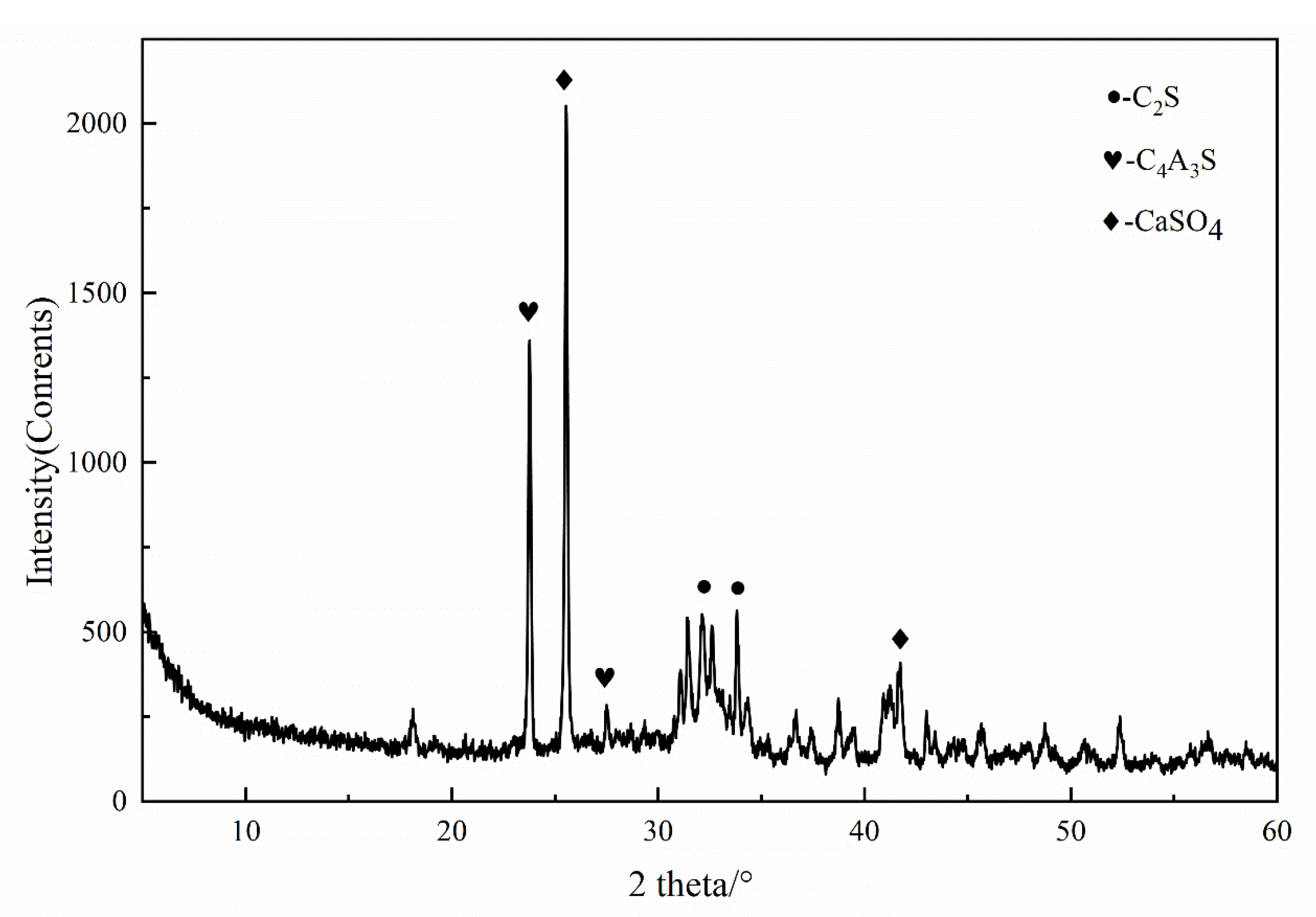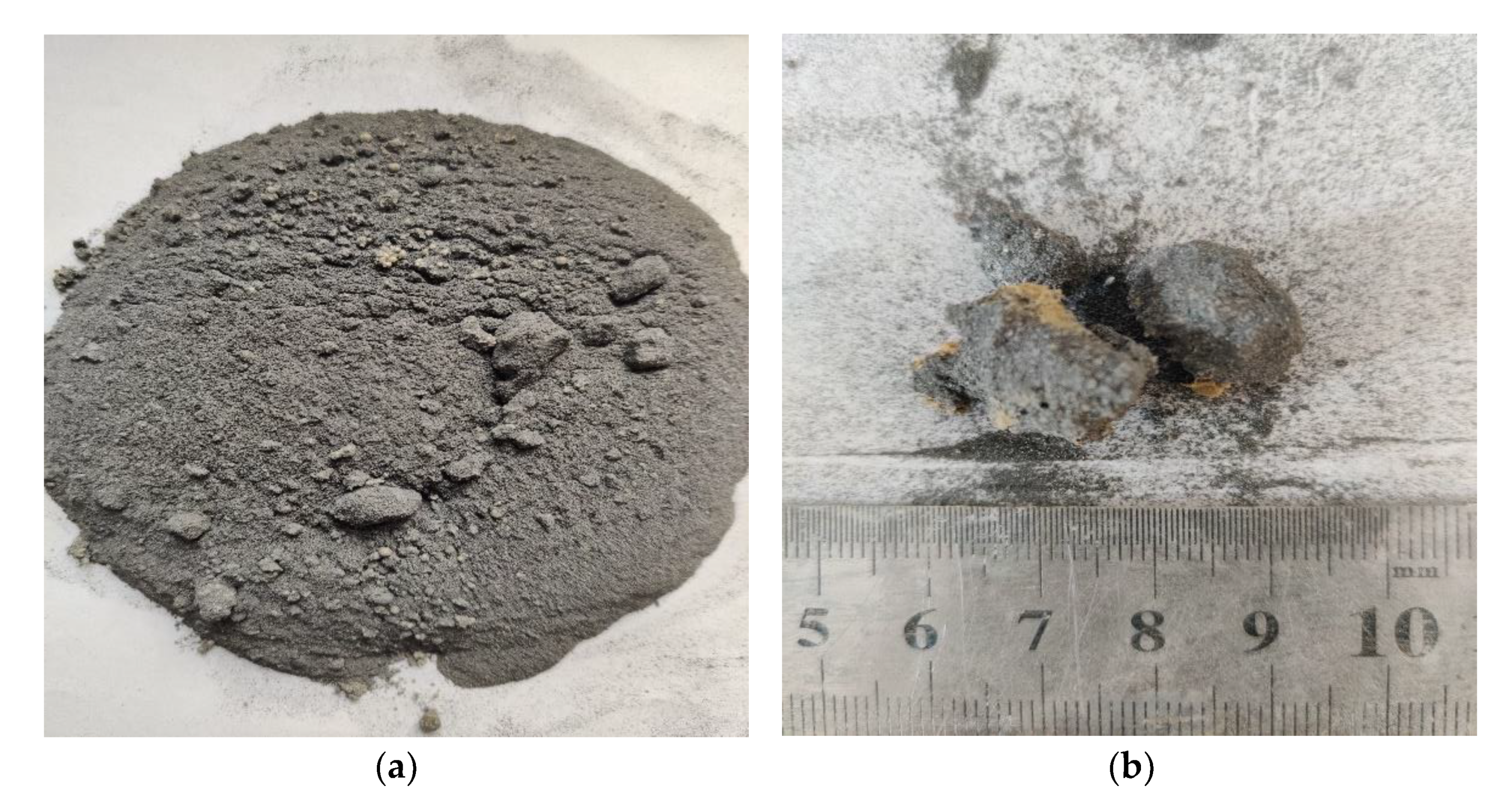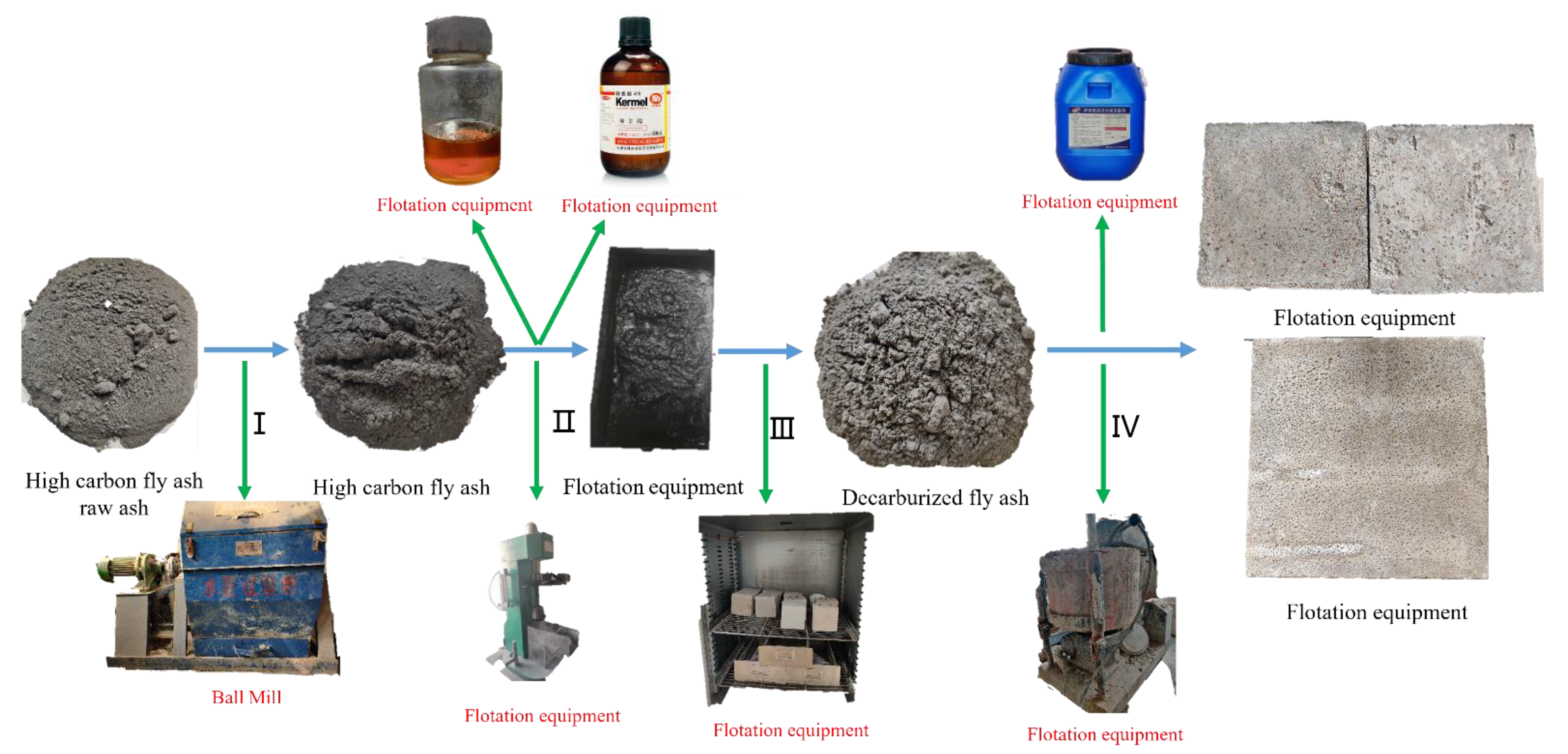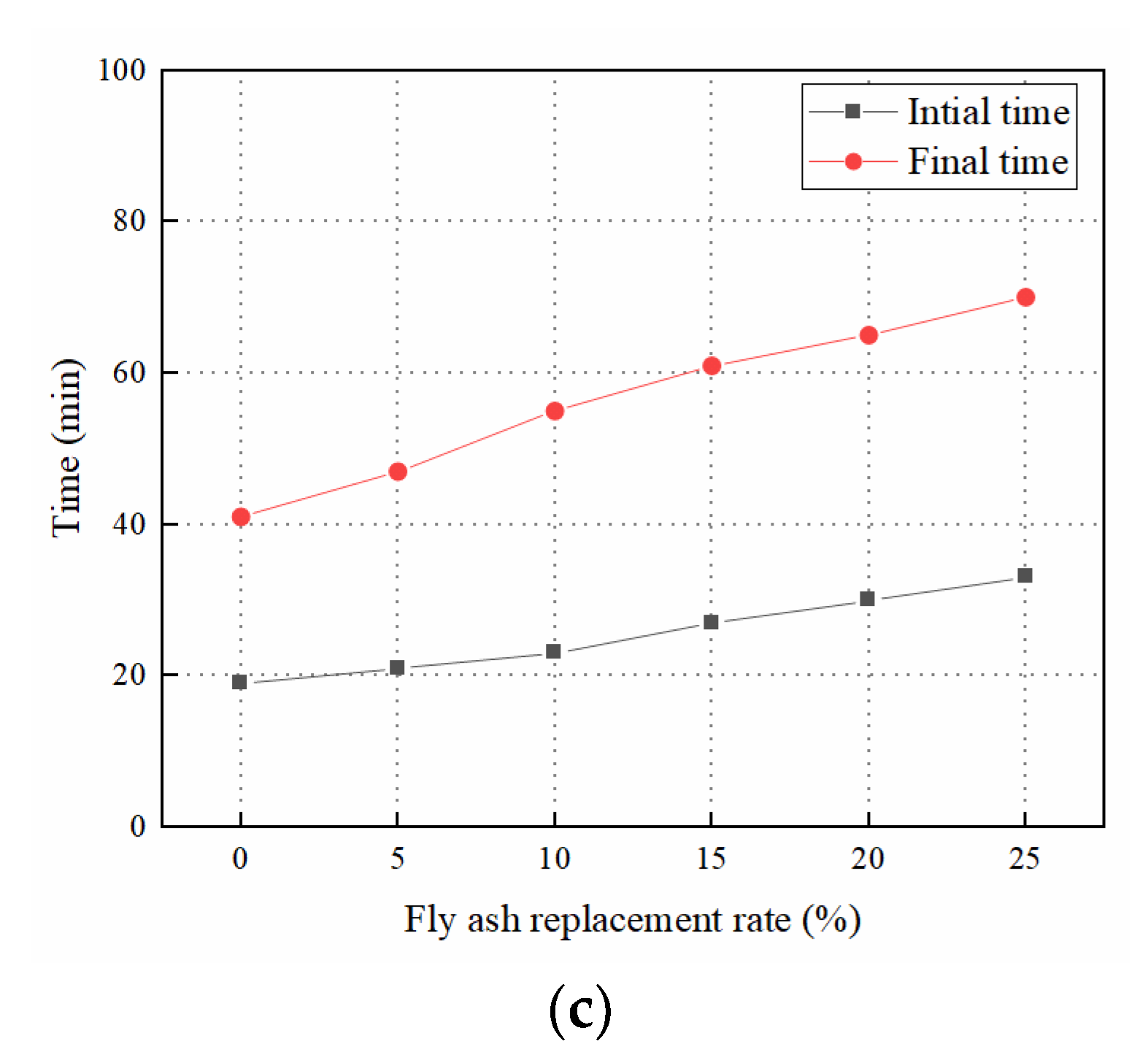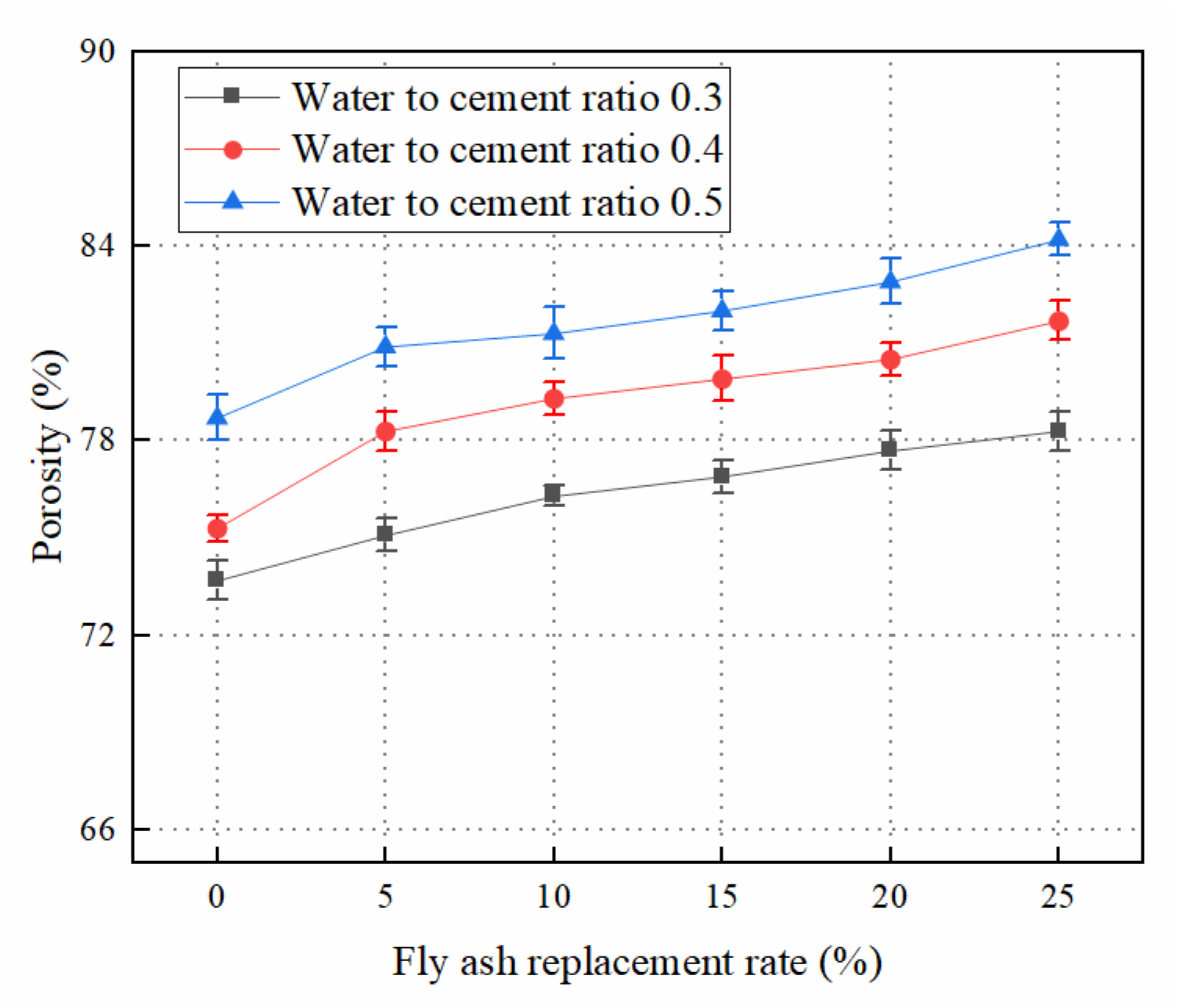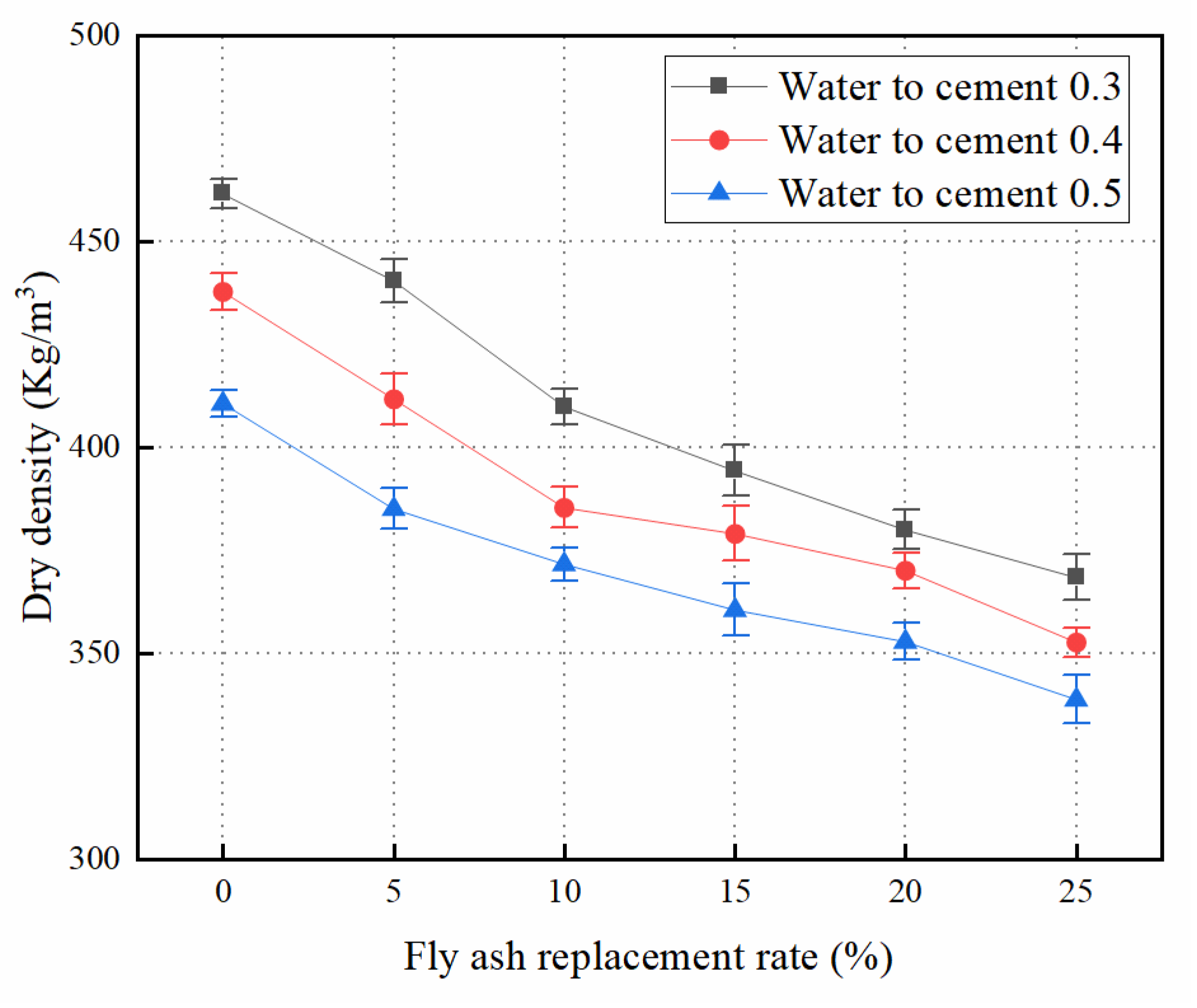1. Introduction
In the current global warming situation, countries have searched for methods and established systems in the fields of construction and industry to reduce CO2 emissions and achieve low-carbon sustainable development. China has also adopted policies such as the “Healthy Building Evaluation Criteria”. Improving the resource utilization rate of construction waste is one of the concerns in China. In response to the policy of low-carbon environmental protection and technological innovation, this study uses decarbonized fly ash to prepare foam concrete for the purpose of green recycling and other uses.
Foam concrete is a new type of thermal material, formed by mixing ng foam with cement and then cast-in-place after mixing with other mixes. The density of this concrete is between 100~2000 kg/m
3 and the thermal conductivity is generally around 0.1 W/(m·k). Compared to ordinary concrete, it is lighter in weight with a better thermal insulation performance and is conducive to long-distance transportation. Its workability is related to the interaction between its blowing agent and cement [
1]. F.K. [
2] prepared foam concrete using cement, expanded vermiculite powder and silica powder and conducted a study on its dry and wet density, water absorption, ultrasonic, compressive strength and thermal conductivity. The results showed that the compressive strength of the foam concrete ranged between 0.4 and 3.7 MPa, the density ranged between 587 and 1040 kg/m
3, and the thermal conductivity ranged between 0.059 and 0.237 W/(m·k). Li [
3] prepared foam concrete by adding insulation and nanoporous aerogel to the foam concrete with a density of 198 kg/m
3 and thermal conductivity of 0.049 W/(m·k) for a new aerogel foam concrete. It can be seen that foam concrete has excellent insulation properties. However, at the same time, the foam concrete itself also has certain problems: low strength, large shrinkage and easy to crack.
In the process of preparing foam concrete from decarbonized fly ash, the utilization of fly ash can also be a further concern. In terms of our environment-energy relationship, our electrical energy comes from coal combustion [
4]. According to statistics, in 2020, China’s coal-fired power generation accounts for 50.2% of the global total, and fly ash emissions are also upwards of 50%, both of which rank first in the world. From the global utilization of fly ash, the utilization rate of fly ash is 25%. Among them, India is 38%, the United States is 65%, and China is 45%. It can be seen that an increasing number of researchers in China are gradually paying attention to the comprehensive utilization of fly ash, which has in turn been strongly supported by the state. At present, the utilization of fly ash in China is mainly used in the fields of construction materials, agriculture, roads and mine rehabilitation, etc., 1. In building materials: Jiang [
5] found that the partial replacement of cement with fly ash is helpful for high-temperature construction in China. Konstantin [
6] found that when the fly ash admixture is 15%, the 7d strength of concrete can reach 20 MPa and the 365d strength can reach 47.7 MPa. 2. In agriculture: It can improve the acidity and permeability of the soil, whilst reducing the swelling rate of the soil. It can also effectively consume the fly ash piled up and landfilled, alleviating the pressure on land and environment. 3. In the road: when the fly ash admixture is between 0% and 60%, its strength decreases with the increase in fly ash. However, when the fly ash admixture is within 40%, it can meet the compressive strength requirements of the road [
7]. In addition, when the admixture is 15–30%, its 28 day compressive strength is 50.8 MPa, which can be used as asphalt pavement [
8]. In addition to the three aspects described above, fly ash can also be used as an external admixture for special concrete to improve the performance of such concrete. Kudva [
9] carried out the proportional design of self-compacting concrete and aggregate-free concrete with high admixture levels. The 28d compressive strength of both concretes reached 60 MPa when the fly ash admixture was 80%. Jung [
10] used rice husk ash, silica fume and fly ash to partially replace cement. While exploring the microscopic aspects, it was also found that the prepared concrete could meet the requirements of the relevant codes for compressive strength and porosity. Fly ash concrete is also more widely used in practical engineering, and Hashmi et al. [
11] examined its members such as beams and slabs and found that the deflection characteristics and cracking patterns of fly ash concrete are similar to those of ordinary concrete. It was also found that the addition of fly ash reduced the chloride ion attack on reinforced concrete [
12]. In addition, other researchers have found that the effect of fly ash on concrete-related properties gradually decreases as the water-to-cement ratio increases [
13]. In summary, it is clear that the research and utilization of fly ash should continue.
The cementitious material of foam concrete is usually cement, but to reduce cost and relieve environmental pressure while improving its performance in all aspects, fly ash can be considered to partially replace cement. Shang [
14] coated the surface of sodium alginate beads with fly ash, thereby synthesizing a new type of inorganic bubbles and partially replacing them with fine aggregates to prepare foam concrete. This demonstrates that the compressive strength and thermal conductivity of the foam concrete prepared by using the new bubbles were 53.8% and 81.1% higher than those of ordinary concrete of the same density class. Chen [
15] found that mixing with a certain amount of fly ash can significantly improve the compressive and flexural strength of aerated concrete. Drochytka [
16] found, after two years of follow-up tests, that the addition of fly ash resulted in a decrease in concrete strength, but noted little change in thermal conductivity. Yuan [
17] prepared a foam concrete mixed with large amounts of lime mud and fly ash. It was found that the addition of lime mud and fly ash reduced the mechanical properties and drying shrinkage of the concrete, and Krishna [
18] came to a similar conclusion. Zhang [
19] studied the effect law of hydrogen peroxide admixture on fly ash foam concrete using the chemical foaming method. It was found that the dry density, strength and thermal conductivity of the concrete decreased with the increase in the blowing agent admixture. It was also found that when the H
2O
2 admixture was in the range of between 5.5 and 7.5%, it caused a significant increase in the pore size. The above-mentioned utilization of fly ash is not well purified. Mao [
20] found that the content of decarburized fly ash above 45 μm was greater than 12%, which could not meet the requirements for the use of Class I fly ash. In addition, polished fly ash can significantly improve the strength of fly ash concrete. In fly ash decarbonization technology, Tao [
21] conducted a kinetic analysis of charged fly ash particles, which can effectively improve the efficiency of decarbonization.
In summary, there is still relatively little research on high carbon fly ash decarburization technology. In addition, in some areas, the fly ash with a high carbon content generated due to technical limitations cannot be effectively utilized. In contrast to previous studies, modified kitchen waste oil is used as a novel trapping agent in this paper. This can not only effectively improve the utilization rate of kitchen waste oil, but, additionally, its ability to change the hydrophobicity of mineral surface far exceeds that of traditional petrochemical-based trapping agents (kerosene). Thus, a decarburized fly ash with a comparable performance to Class I fly ash was obtained. In addition, the decarburized fly ash was combined with foam concrete to evaluate the relevant performance of foam concrete under different water-cement ratios and decarburized fly ash admixtures In order to provide a new idea for sustainable development.
3. Results and Discussions
3.1. Setting Time of Composite Cementitious Materials
Figure 5a–c reflects the setting time of the composite cementitious materials at different DFA substitution rates. It can be seen from the figure that the initial and final setting times of the composite cementitious material increase with the increase in the DFA substitution rate, and the time difference between them also increases. Taking H3-1 and H3-6 as examples, the initial and final setting times of H3-1 were 19 min and 41 min, with a time difference of 22 min. The initial and final setting times of H3-6 were 33 min and 70 min, with a time difference of 37 min. The reason for this phenomenon may be that the increase in DFA doping reduces the content of anhydrous calcium sulfoaluminate used for the hydration reaction in the composite cementitious material system, which further affects the hydration rate. At the same time, fly ash in the hydration process is often combined with Ca(OH)
2 to achieve the “secondary reaction” and cannot directly provide hydration products. This leads to an increase in the setting time of the composite cementitious material system.
It can also be noted that the increase in the water-to-cement ratio also prolongs the setting time of the composite cementitious material. Taking H1-4 and H3-4 as examples, the initial and final setting time of H1-4 is 19 min and 40 min, and the initial and final setting time of H3-4 is 27 min and 61 min. When the water-to-cement ratio was increased from 0.3 to 0.5, the initial and final setting times increased by 8 min and 21 min, respectively. This is primarily because the increase in water-collagen ratio, while increasing the water consumption, is equivalent to diluting the concentration of each ion in the slurry. This leads to a slowing down of the accumulation of hydration products, which is further manifested by an increase in the setting time.
3.2. Porosity
Figure 6 shows the porosity of the foam concrete with different mix ratios. It can be seen from the figure that the porosity of the foam concrete continues increasing with the increase in the DFA substitution. Taking the water-to-cement ratio of 0.4 as an example, the porosity of the foam concrete increased from 75.3% to 81.7% when the substitution rate increased from 0% to 25%. This is mainly because, in the case of the constant water-to-cement ratio, the increase in DFA content will reduce the fluidity of concrete and prolong the setting time of concrete. This reduces the loss of foam during preparation and also gives a better environment for foam morphology to develop, thus increasing the porosity of the concrete. Secondly, the activity of the DFA is much lower than that of cement. In addition, the “secondary hydration reaction” of the DFA is extremely dependent on the hydration product of cement -Ca(OH)
2. The increase in DFA doping reduced the production of Ca(OH)
2. When the amount of DFA is too high and the Ca(OH)
2 generated by hydration is not enough to react completely with the DFA, the unreacted DFA will also increase the porosity of the foam concrete.
Meanwhile, at the same DFA substitution rate, the porosity of the concrete continues to increase with the increase in the water-to-cement ratio. Taking the DFA substitution rate of 15% as an example, the porosity of the concrete increased from 76.9% to 82% when the water-to-cement ratio increased from 0.3 to 0.5. The reason for this phenomenon is the nature of DFA itself. When the water-to-cement ratio increases, it can increase the viscosity of the foam concrete, which reduces the loss of foam in the mixing process and facilitates the development of foam within the slurry. The final expression is the increase in porosity.
3.3. Dry Density
Figure 7 reflects the test results of the dry density of the foam concrete. The dry density of the foam concrete is between 338.89~461.51 kg/m
3. It can be seen from the figure that the dry density gradually decreased with the increase in the DFA substitution rate and the increase in water-to-cement ratio, but it is not linearly correlated.
The reason for this phenomenon may be because DFA has a lower density compared to HBSAC. The increase in the DFA content reduces the density of the composite cementitious material. Secondly, the addition of DFA improves the foaming environment of the foaming agent and increases the foam content in the concrete, in disguise. At the same time, DFA also causes the development of an internal hole structure and prolonged annexation time. This phenomenon becomes increasingly obvious with the increase in the DFA admixture. In addition, according to the existing research surface [
24], the size of the internal pores of concrete shows a negative correlation with dry density. In the mixing process of foam concrete, with the decrease in the viscosity and the increase in fluidity, it leads to the increase in air content in the mixing-molding process, which creates more bubbles inside the concrete. This further reduces the dry density of the foam concrete. Taking group H2 as an example, the dry density of the concrete decreased from 437.7 kg/m
3 to 352.7 kg/m
3 when the fly ash substitution rate increased from 0% to 25%.
In the process of preparing the foam concrete, the increase in the water-to-cement ratio causes an increase in the mixing water quantity. However, most of the water evaporates from the concrete interior as free water during the entire curing age and drying process. At the same time, we know that the water used for the hydration of concrete increases with the proportion of cementitious materials. As the water-to-cement ratio increases, the proportion of cementitious materials gradually decreases, which means that the water used for the hydration reaction is decreasing and the free water is increasing.
According to JG/T 266-2011 “Foam Concrete”, the dry density of all the 18 groups of foam concrete prepared in this test can meet the requirements of A0.5 grade.
3.4. Compressive Strength
Figure 8 reflects the results of the compressive strength measurement of the foam concrete with different mix ratios. From the figure, it can be seen that the compressive strength of the concrete decreases continuously with the increase in the DFA admixture, while keeping the water-to-cement ratio constant. Meanwhile, the H1, H2 and H3 groups showed a sudden drop in DFA content up to 20%, 15% and 10%. The strengths were reduced from 0.72 MPa to 0.48 MPa, 0.71 MPa to 0.52 MPa, and 0.67 MPa to 0.52 MPa, respectively, with reductions of 33.3%, 26.7%, and 22.4%. This is caused by the mineral composition of the cementitious material. The mineral composition of HBSAC is mainly anhydrous calcium sulfoaluminate and dicalcium silicate. In the early stage of the hydration reaction, Aft is mainly formed by the hydration of anhydrous calcium sulfoaluminate to improve the strength, and in the later stage, dicalcium silicate is hydrated to form hydrated calcium silicate and Ca(OH)
2 to provide strength [
25]. Meanwhile, although the DFA with mechanical activation-flotation has higher activity, the hydration products of anhydrous calcium sulfoaluminate can further react with Ca(OH)
2. This means a disguised weakening of the DFA activity. Secondly, due to the relatively slow hydration rate of dicalcium silicate, when the DFA content reaches a certain level, the Ca(OH)
2 generated by hydration is inevitably unable to meet the amount required for the DFA to carry out the “secondary hydration reaction”. This also results in a lot of residual un-reacted DFA inside the concrete, which not only reduces the compactness of the concrete, but also reduces the compressive strength of the concrete.
We can also learn from the figure that an increase in the water-to-cement ratio decreases the compressive strength of concrete at the same DFA substitution rate. Taking H1-4 and H3-4 as examples, the 28 d compressive strengths of both were 0.72 MPa and 0.44 MPa, with a decrease of 38.8%. This is because, although the amount of gelling material is the same for both, H3-4 will obtain more gelling material slurry as the water-to-cement ratio increases. When the water-to-cement ratio is larger, the content of HBSAC in the same volume of cementitious material slurry will be less. In addition, as the main strength contributor, the content reduction of HBSAC will inevitably reduce the strength of the foam concrete. Secondly, due to the same volume of the mold at the time of casting, less HBSAC hydration products distributed in the same volume of space will also make the foam concrete less compact and thus reduce the compressive strength.
According to JG/T 266-2011 “Foam Concrete”, all the 18 groups of foam concrete prepared in this test meet the requirements of C0.3 grade foam concrete.
3.5. Thermal Insulation Performance
This test measures the thermal insulation performance of foam concrete by testing for thermal conductivity, and the measurement results are shown in
Figure 9a. From the figure, it can be seen that with the increase in DFA admixture and water-to-cement ratio, the thermal conductivity of DFA decreases continuously and the thermal insulation performance improves gradually.
The main reason for such phenomena is the increase in porosity, which we usually consider as decreasing the thermal conductivity of concrete. This is because the thermal conductivity of air is much lower than that of cement paste, and the addition of DFA will increase the porosity and pore size inside the foam concrete. Taking group H2 as an example, the porosity of the foam concrete increased from 75.3% to 81.7% when the DFA admixture increased from 0% to 25%, while the thermal conductivity decreased from 0.0977 W/(m·k) to 0.0851 W/(m·k). With the same content of DFA, the increase in the water-to-cement ratio also leads to the formation of more pores inside the dried concrete, increasing the content of internal air. This eventually leads to a decrease in the thermal conductivity of the foam concrete.
Figure 9b collects the data from some researchers on the thermal conductivity of foam concrete [
3,
26,
27,
28,
29] and makes a comparison with the foam concrete prepared in this test. It can be seen from the figure that the thermal conductivity of the foam concrete prepared in this test ranged between 0.0796 and0.1077 W/(m·k). With the exception of the foam concrete prepared using super-insulating nano-multi-air gel, the thermal conductivity of all other foam concretes was higher than that of the foam concrete prepared in this test. Meanwhile, according to JG/T 266-2011 “Foam Concrete”, all the 18 groups of foam concrete prepared in this test meet the requirements of A05 grade foam concrete.
3.6. SEM Analysis of Foam Concrete
To further verify the above analysis, SEM microscopic analysis of H2-1, H2-3 and H2-6 was performed, as shown in
Figure 10a–c. As can be seen from the figure, the 28 d hydration products of the three groups of foam concrete are mainly pin-stick-like Aft laps and are filled with partial gel. Meanwhile, in H2-3 and H2-6, the fly ash particles are filled between the hydration products and covered with the product of “secondary hydration reaction”, hydrated calcium silicate. In addition, the development of Aft was limited with the increase in the DFA substitution rate. The morphology gradually changed from rod-like to needle-like and the unreacted DFA particles gradually increased. This also verifies that the main cause of the change in the properties related to foam concrete are the deterioration of the Aft morphology, the reduction in the hydration products and the weakening of the DFA “secondary hydration reaction”.
